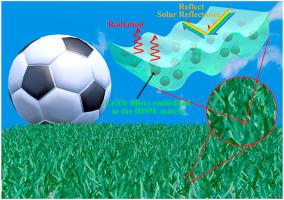当前位置:
X-MOL 学术
›
Sol. Energy Mater. Sol. Cells
›
论文详情
Our official English website, www.x-mol.net, welcomes your
feedback! (Note: you will need to create a separate account there.)
Passive daytime radiative cooling inorganic-polymeric composite artificial lawn for the alternative to the natural lawn
Solar Energy Materials and Solar Cells ( IF 6.3 ) Pub Date : 2021-01-01 , DOI: 10.1016/j.solmat.2020.110783 Zhangbin Yang , Tiankai Jiang , Jun Zhang
Solar Energy Materials and Solar Cells ( IF 6.3 ) Pub Date : 2021-01-01 , DOI: 10.1016/j.solmat.2020.110783 Zhangbin Yang , Tiankai Jiang , Jun Zhang

|
Abstract The natural lawn needs complex maintenance (e.g., fertilizer dressing, manicuring, soil disinfection and disinsection), so the artificial lawn is increasingly desired and applied in the sports arena. However, the most artificial lawns are made of the organic materials, which could accumulate the thermal energy under direct sunlight. The accumulated thermal energy also leads to increasing the temperature of the artificial lawn and its surroundings, which eventually impact the athletic experience. Moreover, an efficient, eco-friendly, and economical technique that can provide the cooling for the artificial lawns without extensive energy input is lacking. Herein, a novel inorganic-polymeric composite for preparing passive daytime radiative cooling artificial lawn using chromium oxide (Cr2O3) particle-embedded high-density polyethylene (HDPE) is demonstrated. By reflecting 50% NIR irradiance and radiating heat through the atmosphere’s long-wave infrared transmission window (LWIR, eLWIR = 0.86), this composite-covered device displayed a temperature of 30.7 °C, much lower than those of HDPE-covered device (43.4 °C) under solar simulator (intensity~0.34 W/cm2). Similarly, this composite exhibits a better cooling effect than the neat HDPE under direct sunlight. Moreover, for further improving the cooling property of the composite, the titanium dioxide (TiO2) was utilized to enhance the reflectance of the HDPE/Cr2O3 composite without affecting the visual effect and thermal emissivity, where the total reflectance increases by 5%. Meanwhile, the outdoor thermal measurement showed that the cooling effect of the HDPE/Cr2O3/TiO2 composite artificial lawn is on a par with that of the natural lawn.
中文翻译:

替代天然草坪的被动日间辐射冷却无机聚合物复合人造草坪
摘要 天然草坪需要复杂的养护(如施肥、修剪、土壤消毒、除虫等),因此人造草坪在运动场中越来越受到人们的青睐和应用。然而,大多数人造草坪是由有机材料制成的,在阳光直射下可以积累热能。累积的热能还会导致人造草坪及其周围环境的温度升高,最终影响运动体验。此外,还缺乏一种高效、环保且经济的技术,可以在不大量能源输入的情况下为人造草坪提供冷却。在此处,展示了一种使用氧化铬 (Cr2O3) 颗粒嵌入的高密度聚乙烯 (HDPE) 制备被动日间辐射冷却人造草坪的新型无机聚合物复合材料。通过反射 50% 的 NIR 辐照度并通过大气的长波红外透射窗口 (LWIR, eLWIR = 0.86) 辐射热量,这种复合材料覆盖的设备显示出 30.7 °C 的温度,远低于 HDPE 覆盖的设备 (43.4 °C) 在太阳模拟器下(强度~0.34 W/cm2)。同样,这种复合材料在阳光直射下表现出比纯 HDPE 更好的冷却效果。此外,为了进一步提高复合材料的冷却性能,在不影响视觉效果和热发射率的情况下,利用二氧化钛(TiO2)提高了HDPE/Cr2O3复合材料的反射率,其中总反射率增加 5%。同时,室外热测量表明,HDPE/Cr2O3/TiO2复合人造草坪的降温效果与天然草坪相当。
更新日期:2021-01-01
中文翻译:

替代天然草坪的被动日间辐射冷却无机聚合物复合人造草坪
摘要 天然草坪需要复杂的养护(如施肥、修剪、土壤消毒、除虫等),因此人造草坪在运动场中越来越受到人们的青睐和应用。然而,大多数人造草坪是由有机材料制成的,在阳光直射下可以积累热能。累积的热能还会导致人造草坪及其周围环境的温度升高,最终影响运动体验。此外,还缺乏一种高效、环保且经济的技术,可以在不大量能源输入的情况下为人造草坪提供冷却。在此处,展示了一种使用氧化铬 (Cr2O3) 颗粒嵌入的高密度聚乙烯 (HDPE) 制备被动日间辐射冷却人造草坪的新型无机聚合物复合材料。通过反射 50% 的 NIR 辐照度并通过大气的长波红外透射窗口 (LWIR, eLWIR = 0.86) 辐射热量,这种复合材料覆盖的设备显示出 30.7 °C 的温度,远低于 HDPE 覆盖的设备 (43.4 °C) 在太阳模拟器下(强度~0.34 W/cm2)。同样,这种复合材料在阳光直射下表现出比纯 HDPE 更好的冷却效果。此外,为了进一步提高复合材料的冷却性能,在不影响视觉效果和热发射率的情况下,利用二氧化钛(TiO2)提高了HDPE/Cr2O3复合材料的反射率,其中总反射率增加 5%。同时,室外热测量表明,HDPE/Cr2O3/TiO2复合人造草坪的降温效果与天然草坪相当。











































 京公网安备 11010802027423号
京公网安备 11010802027423号